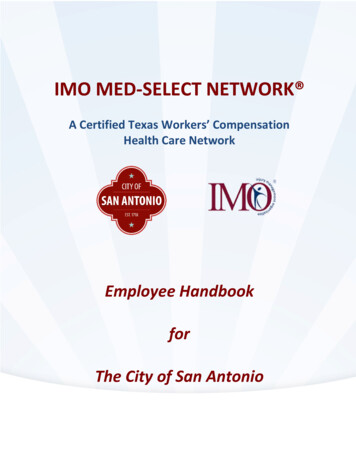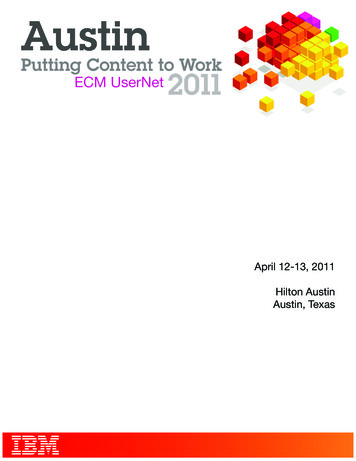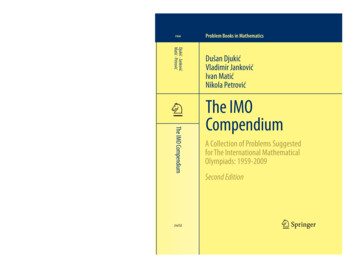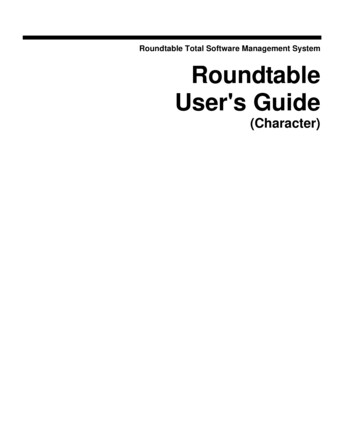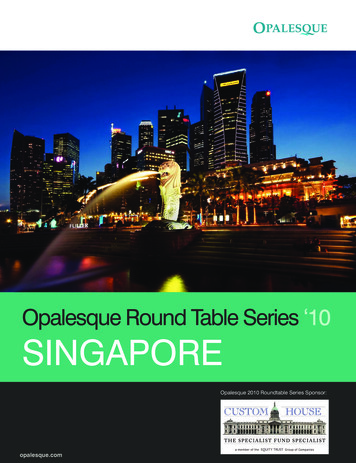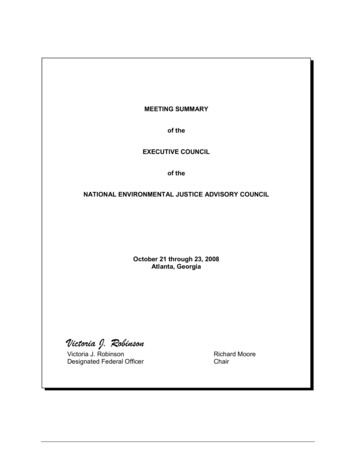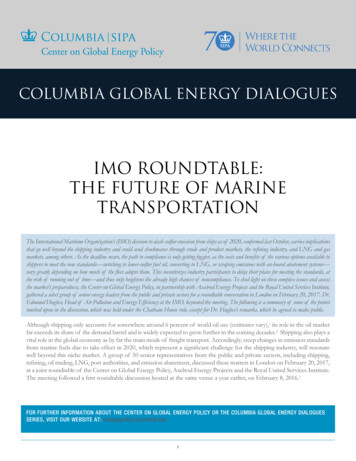
Transcription
COLUMBIA GLOBAL ENERGY DIALOGUESIMO ROUNDTABLE:THE FUTURE OF MARINETRANSPORTATIONThe International Maritime Organization’s (IMO) decision to slash sulfur emission from ships as of 2020, confirmed last October, carries implicationsthat go well beyond the shipping industry and could send shockwaves through crude and product markets, the refining industry, and LNG and gasmarkets, among others. As the deadline nears, the path to compliance is only getting foggier, as the costs and benefits of the various options available toshippers to meet the new standards—switching to lower-sulfur fuel oil, converting to LNG, or scraping emissions with on-board abatement systems—vary greatly depending on how much of the fleet adopts them. This incentivizes industry participants to delay their plans for meeting the standards, atthe risk of running out of time—and thus only heightens the already high chances of noncompliance. To shed light on these complex issues and assessthe market’s preparedness, the Center on Global Energy Policy, in partnership with Axelrod Energy Projects and the Royal United Services Institute,gathered a select group of senior energy leaders from the public and private sectors for a roundtable conversation in London on February 20, 2017. Dr.Edmund Hughes, Head of Air Pollution and Energy Efficiency at the IMO, keynoted the meeting. The following is a summary of some of the pointstouched upon in the discussion, which was held under the Chatham House rule, except for Dr. Hughes’s remarks, which he agreed to make public.Although shipping only accounts for somewhere around 6 percent of world oil use (estimates vary),1 its role in the oil marketfar exceeds its share of the demand barrel and is widely expected to grow further in the coming decades.2 Shipping also plays avital role in the global economy as by far the main mode of freight transport. Accordingly, steep changes in emission standardsfrom marine fuels due to take effect in 2020, which represent a significant challenge for the shipping industry, will resonatewell beyond this niche market. A group of 50 senior representatives from the public and private sectors, including shipping,refining, oil trading, LNG, port authorities, and emission abatement, discussed these matters in London on February 20, 2017,at a joint roundtable of the Center on Global Energy Policy, Axelrod Energy Projects and the Royal United Services Institute.The meeting followed a first roundtable discussion hosted at the same venue a year earlier, on February 8, 2016.3FOR FURTHER INFORMATION ABOUT THE CENTER ON GLOBAL ENERGY POLICY OR THE COLUMBIA GLOBAL ENERGY DIALOGUESSERIES, VISIT OUR WEBSITE AT: energypolicy.columbia.edu1
IMO ROUNDTABLE: THE FUTURE OF MARINE TRANSPORTATIONShipping’s central place in the global economy hinges on its role as the main mode of freight transportation, accountingfor 80 percent of the trade in physical goods. The bunker fuel market’s importance to energy markets in general stems inpart from the fact that marine transportation takes up the bulk of the supply of high-sulfur residual fuel oil, a by-productof refining for which there are few other uses. By greatly reducing demand for that fuel, the new rules could make itdifficult for refiners to dispose of this otherwise largely unwanted product.The marine sector also matters greatly to climate and environmental policy as a leading and—until now—loosely regulatedsource of air emissions, including sulfur dioxide, nitrogen oxide, and CO2. According to some estimates, a single largecontainer ship emits as much sulfur dioxide as 50 million diesel cars, while a medium- to large-size container ship runningat 70 percent maximum power causes as much particulate emissions as 500,000 new trucks in China.4 Most sulfur oxideemissions from ships occur within 400 km of coastal communities, leaving some 230 million people in the world’s top100 ports directly exposed.5CLOSING A LOOPHOLELike aviation, shipping has long been largely left alone by environmental regulators. As emissions standardsgradually tightened for the rest of the oil sector, shipping and aviation were left behind. As was widely notedduring COP21, both sectors were excluded from the Paris agreement of December 2015.Change is, however, in the air. For example, the International Civil Aviation Organization (ICAO) has set fuelefficiency targets that call for an average 1.5 percent annual gain for the sector, along with a goal to halve itsnet CO2 emissions by 2050 compared to 2005 levels.6 China has made aviation—including civil air passengertransport, cargo transport, and airports—one of eight industries to be covered by its national emissions tradingscheme (ETS) from 2017 onward.7Likewise, the gap between air emissions from shipping and land transportation is slowly closing. The first stepsgo back to May 2006, when an emission control area (ECA) was established in the Baltic Sea, capping exhaustsulfur dioxide from ships to a level equivalent with the air emissions produced from burning fuel with a maximumsulfur content of 1.5 percent (1.5 percent S equivalent). In November 2007, that first European ECA wasextended to the North Sea and the English Channel, and in July 2010 the cap was lowered to 1 percent S acrossthe European ECAs. In August 2012 a North American ECA was established in a 200-nautical-mile coastal bandaround the United States, including Hawaii and Canada, subsequently extended to the US Caribbean Sea area inJanuary 2014. Sulfur limits were further reduced to 0.10 percent in both Europe and the Americas as of January1, 2015. More recently, China unilaterally established its own ECAs along parts of its coast, with an initial 0.5percent sulfur limit to be progressively implemented (first at berth within port limits, then in coastal areas by2019). That limit may subsequently be tightened to 0.1 percent S in 2020.8 Outside of the ECAs, sulfur standardswere cut from 4.5 percent to 3.5 percent of as January 1, 2012.An IMO decision to further reduce sulfur emission levels from ships to 0.5 percent outside ECAs takes these effortsto a new level. The move was first announced in 2008 but with some uncertainty as to its timing; even as the IMOannounced it, the IMO hinted at possible delays if low-sulfur fuel supply were found to be insufficient to let shippersmeet the new standards in time. It advised that a final decision would be made by 2018; depending on the findingsof a commissioned study of fuel-oil availability, the January 1, 2020, target date would be either upheld or postponedby up to five years. At the CGEP 2016 joint workshop on marine bunker fuels, however, Dr. Edmund Hughes,the IMO’s head of Air Pollution and Energy Efficiency, went on the record to note that in order to give marketparticipants more time to adjust, a final decision on timing would be moved up to October 2016.CENTER ON GLOBAL ENERGY POLICY COLUMBIA SIPA2
IMO ROUNDTABLE: THE FUTURE OF MARINE TRANSPORTATIONThe IMO’s decision to stick to the 2020 deadline was greeted with a measure of surprise when it was dulyannounced in October 2016, as many analysts and market watchers had apparently bet on a delay. In the “NewPolicies Scenario,” or base case of its November 2016 World Energy Outlook, the International Energy Agencythus noted that “the global cap on maritime sulfur is cautiously assumed to take effect from 2025.”9 Dr. Hughestook great care at the 2016 CGEP roundtable not to prejudge the outcome of the fuel availability study; however,nothing in his remarks could have been construed as supporting such expectations.IMO FUEL STUDY: DEFINING “AVAILABLE”Speaking at the second joint CGEP roundtable on bunker fuels in February 2017, Dr. Hughes delivered agenerally soothing but nuanced report on the findings of the fuel availability study 10 and the IMO’s assessmentof the shipping industry’s readiness. The bottom line is that low-sulfur fuel supply is expected to be sufficient tomeet the new standards by 2020—hence the decision to stick with that target date. Yet the study’s modeling alsomakes clear that significant shifts will need to occur in refinery utilization and capacity, crude slate, and tradingpatterns. No single solution will satisfy the market on its own, but there will be a need for an “all-of-the-above”mix of industry responses, including a large shift in demand from high-sulfur to low-sulfur fuel oil, continueddemand for high-sulfur oil from ships fitted with exhaust gas cleaning systems (EGCS), or scrubbers, along witha higher penetration of LNG as shipping fuel.The good news is that in each of the study’s three scenarios, supply appears adequate—but in the high-demandcase just barely so. “The modeling results indicate that the refinery industry can produce sufficient amountsof the required quality in the base case, the high case and the low case while at the same time supplying othersectors with the petroleum products that they require,” Dr. Hughes said. In the base case, capacity is more thanadequate: the refining industry can produce as much as 24 percent more compliant bunker fuel than required. Inthe high-demand case characterized by low scrubber penetration and robust shipping activity, however, excesscapacity is marginal. In this scenario, refinery production only exceeds demand of compliant-quality bunker fuelby 2 percent.Even in the low-demand case, “adequate” supply means breaking from business as usual, including a jump ininterregional shipping of bunker fuels. That is because the global balance between bunker fuel supply and demandmasks in all configurations pronounced regional imbalances. “In all cases,” said Dr. Hughes, “but especially inthe high-demand case, interregional transport of marine fuel will be required. If supply and demand is to bebalanced in all regions, the Middle East and in some cases Europe and Latin America may have to export fuelwith a sulfur content of 0.5 percent or less to other regions.”Diving into the model’s main assumptions, Dr. Hughes noted that changing sulfur standards will increasinglyforce the shipping industry to compete for the same type of fuel with other industry sectors, such as road freighttransportation, personal vehicles (in Europe), or power generation (in stand-alone diesel units common in manyemerging markets), making it necessary to forecast both bunker demand for shipping and total oil demand.Projections to 2020 were based on 2012 estimates drawn from a 2014 IMO study of greenhouse gas emissions.Shipping demand is projected to grow by 8 percent in the base case, to 12,814 PJ in 2020 from 11,877 PJ in 2012.(This is a pace of growth broadly in line with consensus market expectations reflected in IEA forecasts.) TheIMO study sees LNG use for marine transport rising to 12 million tons from 8 million tons—steep growth froma very low base. Scrubber adoption is a key input variable; in the base case, 3,800 ships are fitted with EGCS,versus 1,200 in the high-demand case and 4,100 in the low-demand case (the more ships are fitted with scrubbers,the less demand there is for low-sulfur fuel). Depending on these assumptions, 2020 bunker fuel demand ranges3energypolicy.columbia.edu
IMO ROUNDTABLE: THE FUTURE OF MARINE TRANSPORTATIONby 1.5 million bpd, from a low of 282 million tons (5.17 million bpd) to a high of 364 million tons (6.67 millionbpd), with a middle case of 320 million tons (5.87 million bpd), up from 300 million in 2012.Current low levels of EGCS penetration would on the face of it support the IMO’s high-demand scenario, unlessthe pace of EGCS orders picks up soon. On the other hand, some participants indicated on the sidelines of themeeting that they thought the IMO 2014 greenhouse gas study overstated bunker demand. Some participantsalso argued that the IMO fuel availability study underestimated the industry’s recent fuel-efficiency gains, as wellas the scope for further improvements, which would in turn lead to further overstatement of future needs.Additional assumptions regard forecast changes in global and regional refining capacity, oil prices (Brent pricesare projected at 77/barrel in 2020), and refinery utilization rates (hydroprocessing and desulfurization units,etc.). Crude distillation capacity is assumed to grow by 8 percent, coking capacity by 35 percent, hydrocrackingby 37 percent, and catalytic cracking by 6 percent.Most of shipping demand for low-sulfur fuel by 2020 ends up being met by a new low-sulfur residual fuel oilblend (LSFO) rather than marine gas oil (MGO). Global MGO production plunges by almost 40 percent to 39million tons in 2020 from 64 million tons in 2012. In contrast, production of LSFO, a product that did not existin 2012, surges to 233 million tons. High-sulfur fuel oil demand becomes restricted to a relatively small numberof EGCS-equipped vessels and plummets by more than 80 percent, to 36 million tons, from 228 million tons in2012.To meet the new standards, a triple adjustment is needed. Refiners must change their crude slate in favor oflower-sulfur feedstock. This will likely entail shifts in crude oil markets and price spreads between light, sweet,and heavy, sour crude grades. Even Middle East refiners, which normally rely on a relatively high-sulfur diet,might have to switch to lower-sulfur crudes; the high-demand case “requires refineries in the Middle East andAsia to increase the utilization rates of their refining and processing units and to change their crude slates. Forexample, the average sulfur content of the crude slate in the Middle East will need to be lowered from 2.01percent in the base case to 1.99 percent in the high-demand case.”In addition to changes in the crude slate, there will be shifts in the manufacturing process. Not only does meetingthe new standards entail higher crude distillation, coking, and hydrocracking capacity, but new forms of blendingwill also be required. All compliant fuels, said Dr. Hughes, will be blends of several refinery streams.Finally, the trading patterns of suppliers (or the bunkering patterns of ships) must be adjusted to correct regionalimbalances: “In most cases the Middle East has an oversupply, while in some cases other regions have a higherproduction than consumption as well. Regional imbalances can be addressed by transporting fuels or by changingvessels’ bunkering patterns.”ENFORCEMENT CHALLENGESA major topic of discussion raised by Dr. Hughes’s presentation was an issue on which it did not dwell prominently,that of enforcement and (non-) compliance. In addition to the three ways of meeting the new sulfur targets—scrubbers, LNG, low-sulfur compliant fuels—identified by the IMO study, participants cautioned that “as a shipowner there is a fourth, unconventional option to consider and that is not to comply with MEPC 70”; that is, thepolicy set at the 70th session of the IMO’s Marine Environment Protection Committee (MEPC 70), the bodythat set January 1, 2020, as entry-into-force date of the 0.5 percent global sulfur in marine fuel cap.CENTER ON GLOBAL ENERGY POLICY COLUMBIA SIPA4
IMO ROUNDTABLE: THE FUTURE OF MARINE TRANSPORTATIONSeveral discussants predicted noncompliance would be pervasive due both to the cost and difficulties of meetingthe new specs and the IMO’s lack of enforcement capacity. Lax inspections and toothless penalties in theECAs hint at even weaker implementation on the high seas, where inspection is even more problematic. Indeed,participants suggested, noncompliance may constitute one of the industry’s main responses to the new regulations.The potential for lax enforcement and sporadic implementation of the new measures is an issue of grave concernto industry, since it would not make for a level playing field but would effectively penalize compliant companiesand put them at a disadvantage versus delinquent ones.Quality standards (such as the IMOs) are inherently more challenging to enforce than technical ones, sincecompliance is less straightforward to assess. As far as quality standards go, however, emission standards for shipsare especially problematic due to a combination of jurisdictional and technical factors. There is no environmentalpolice patrolling the high seas. The IMO does not have jurisdiction over international waters, nor does it haveenforcement powers. It has not been mandated to verify compliance. The performance history and commitmentof member states, which are responsible for enforcing maritime rules in coastal waters, varies greatly by country.On the high seas, that responsibility falls to flag states such as Liberia or the Marshall Islands, whose enforcementcapacity is limited at best.From a technical standpoint, too, enforcing sulfur emission standards for ships raises difficulties. In ECAs, compliancewith sulfur rules is typically verified via book checking, which is easy to tamper with. In some circumstances theauthorities request a fuel sample, but there are not many technically able inspectors who can carry out these checks.Inspections are usually done in ports; however, port authorities cannot test on previously used fuel.Enforcement via sulfur “sniffers,” satellite detection, and/or unannounced flyover was found to be the mostefficient to date based on examples from monitoring efforts in ECAs. However, such techniques require adedicated team and substantial investment, which few countries or flag states can afford.Most ports find it difficult to impose fines on ships for violating environmental rules. When they do, the amountstend to be negligible. Violations are treated as administrative offences rather than criminal ones. One participantcited a case in which the guilty party was charged a grand total of 15—less than a parking ticket. A 40 millionfine imposed on a cruise ship in the United States for unlawful water discharge appeared to be an exception tothe rule. Fine amounts tend to pale in comparison with the “rewards” that can be gained from bending the rules.In the ECAs, according to research conducted by one of the participants, noncompliance may today be as highas 20 percent, even in the absence of any practical barrier to meeting the rules, considering that low-sulfur fuelsupply today is more than adequate. This does not augur favorably for the implementation of standards that mayraise much greater challenges to satisfy. Some discussants felt that marine fuel distribution and marketing madeit easy for suppliers to “fall short” of contractual commitments and fostered a culture of fraud and chroniccontract violation that could prove a fertile ground for noncompliance.Participants noted that the challenge for IMO member states was to ensure collective enforcement of the newmeasures. Only a shared, credible threat of punishment if caught cheating can drive demand for new fuels, whichin turn will drive the investments required to make those fuels available. There was widespread agreement aroundthe table that enforcement was the biggest challenge. Effective enforcement measures require coordination andcommitment from flag states and port authorities, as well as needed investments. The IMO lacks, however, boththe funds and the authority to set up a flotilla capable of enforcing its rules on the high seas.5energypolicy.columbia.edu
IMO ROUNDTABLE: THE FUTURE OF MARINE TRANSPORTATIONDr. Hughes conceded that the strength of international regulations lies in their enforcement, with the needfor a level-playing field in the industry important to ensure fair competition. But he pointed to positive signsas well. With regard to consistent enforcement of the requirements, the IMO had approved “guidelines foronboard sampling for the verification of the sulfur content of fuel oil used on board ships.” It also approved theamendments of Appendix V of MARPOL Annex VI,11 “Information to be included in the bunker delivery note,”which requires bunker suppliers to provide fuel buyers with written, detailed information on their deliveries.12The expectation is that shipping industry players will lead by example because they know that widespreadnoncompliance could lead to a call for more rules, including, for example, a ban on the carriage of noncompliantfuels by ships not fitted with an approved EGCS. In certain jurisdictions, enforcement is taken seriously, Dr.Hughes noted. Compliant companies will exercise pressure to bring delinquent competitors in line, includingrequesting their flag states to work through IMO to toughen rules, if required.Should the 2020 requirement fail to be uniformly implemented across the board, member states could take it up withinthe framework of the Paris Memorandum of Understanding on Port State Control (Paris MoU PSC). For example,already at its 49th Committee meeting of May 2016, the Paris MoU agreed on a “Concentrated Inspection Campaign” onMARPOL Annex VI in 2018, designed to bolster compliance with the existing rules and to prepare more PSC authoritiesfor the forthcoming 2020 rule.Finally, some participants took comfort in the high degree of concentration of the shipping industry, notingthat noncompliance would not equally affect all firms but would likely be more characteristic of smaller players.Ship owners operating fleets of up to 500–600 vessels daily would be more likely to comply, despite the largeinitial investments that may be involved. Representatives of companies operating such large fleets present at themeeting expressed their resolve to lead by example. Economies of scale and the resulting efficiency gains mightmore than offset for these firms the cost of noncompliance by smaller players.13 Technology may also help, with“smart engines” enabling effective quality control. Any country unsatisfied with the shipping sector’s response toIMO regulations may take the matter into its own hands and issue new policies, a participant argued.A participant asked if the IMO would establish a task force to deal with enforcement issues. Dr. Hughes saida draft work program had been prepared ahead of MEPC 71 in July 2017, the scope of which will considerenforcement and transitional issues, including those associated with fuel quality and supply.BUNKER SUPPLIERS ON THE FENCEReviewing the various options identified by the IMO report for ship owners and operators to get into compliancewith the new sulfur rules, roundtable participants noted that while the standards had been attracting growing scrutinyfrom all concerned parties, few investment decisions had been taken just yet. Even as they credited the IMO withbringing clarity to the market by upholding the January 2020 deadline, they cautioned that uncertainty on executionwas only rising.On the fuel-supply front, few refiners appear to be factoring the bunker rules into their planning. With a fewexceptions, current refinery expansion plans, although they will directly or indirectly affect the supply of residualfuel oil and middle distillates, do not appear to be primarily driven by bunker fuel considerations. Given the shippingindustry’s uncertain response to the new rules, those refiners for whom the bunker market is only a sideline are sittingon the fence. For many refiners, participation in the bunker market is too peripheral to drive investment decisions,and the small volumes supplied do not justify the hefty cost of capacity upgrades.CENTER ON GLOBAL ENERGY POLICY COLUMBIA SIPA6
IMO ROUNDTABLE: THE FUTURE OF MARINE TRANSPORTATIONLarger bunker suppliers have been experimenting with new LSFO blends and are positioning themselves to offershippers multiple and flexible fuel options, including MGO, LSFO, regular high-sulfur residual fuel oil (HSFO), andeven LNG. Those refiners with desulfurization capacity expansion projects underway will naturally tend to be at anadvantage in supplying low-sulfur bunker fuels. The longer shippers defer their response to the new specs, the morelikely they will be to rely, at least initially, on lower-sulfur fuel oil, since that is the option with the shortest lead timeand lowest upfront investment. The resulting burst of lower-sulfur fuel demand from ships stands to deliver fuelsuppliers with windfall earnings via steep, but perhaps brief price gains.Many analysts reckon incremental refinery capacity projects may add up to 1 million bpd or more of global distillateproduction capacity by 2020. This will go some ways toward meeting what could amount to 2 million bpd-2.5 millionbpd of incremental lower-sulfur fuel demand, according to market participants—leaving a 1 million bpd shortfall.Bridging that gap will call for increased refinery utilization rates, a shift in the crude slate toward lower-sulfur grades,and increased product blending and shipping.Given the long lead time of refinery projects, all incremental processing capacity expansion plans that will comeon line by 2020 have already been decided, participants said. In addition to favoring low-sulfur fuel producers, newbunker fuel demand will put a premium on blending. Much of the new demand will be met by hybrid fuels producedfrom multiple refinery streams. Companies with competitive access to storage tank farms and infrastructure assetsused for shipping and blending fuel components will benefit, as will trading firms adept at spotting and seizingarbitrage opportunities.Conversely, reduced demand for high-sulfur fuel oil will undermine smaller, less sophisticated refineries, notably inEurope, discussants noted. The market could be in for a new round of OECD refinery closures. Pressure will continueto build on simple Russian refineries—a leading source of global HSFO supply—to upgrade or close down. Largeamounts of refining capacity have already been shuttered in Europe and Japan in recent years. A new round of industryrestructuring, notably in Europe, would further concentrate the bunker market into the hands of a small group ofmega-suppliers with great flexibility and diversity across products and geographies. Small refiners with comparativelyhigh residual fuel oil yields would be at increased risk of closure. Others would benefit from their demise.The benefits of increased low-sulfur fuel demand may prove fleeting, however, as a widening price spread betweenLSFO/ MGO and HSFO would incentivize investment in scrubbers, which in turn would support HSFO.EGCS: MANY INQUIRIES, FEW ORDERSRepresentatives from the scrubber industry reported a material increase in inquiries since November 2016, after theIMO reaffirmed its January 2020 deadline, but no meaningful impact on their order book just yet. Scrubbers are bigticket items, with a price tag ranging from 1 million to 6 million depending on size and specifics. Typical scrubbersaverage around 2 million, with another 1 million for installation. Installing a scrubber also requires that the ship beput in dry dock for some time. And scrubbers take up space and may require cargo space to be sacrificed, which maynot always be cost-effective. There are no enormous breakthroughs in term of size. Thus, retrofitting a vessel withEGCS technology only makes sense if HSFO trades at a deep enough discount to lower-sulfur fuel to offset costsand the vessel’s life expectancy is long enough to allow for payback. Not surprisingly, most orders to date have beenfor new builds rather than retrofits.The latest flurry of inquiries echoes the rush that preceded the tightening of sulfur standards in ECAs in January2015, industry participants said. Shipping companies are scrambling to assess scrubber options and costs. Given bothrelatively long lead times and industry capacity constraints, however, the lack of investment decision so far makes it7energypolicy.columbia.edu
IMO ROUNDTABLE: THE FUTURE OF MARINE TRANSPORTATIONunlikely that scrubbers will play a big part in the initial response to the new sulfur specs. In addition to the two weeksit takes to install most scrubbers, EGCSs take months to build to measure. They are not picked off the shelf. Thus,it takes approximately 6–7 months to build a retrofit for a tanker and 9–10 months for a container ship.Scrubber manufacturing capacity is constrained, so a sudden rush of orders could further stretch wait times. Even drydock space to accommodate fitting orders is finite.One concern for scrubber manufacturers was that unless orders arrive in a reasonable timeframe, they would notbe able to meet the expected demand by 2019. Suppliers are willing to invest to achieve production targets butdepend on partners and subsuppliers who have their own constraints.Participants noted additional concerns associated with scrubbers, notably as regards the disposal of wash water,which is discharged to sea. Some open-loop systems discharge the wash-water without any treatment or filtration,a practice that is questioned by some and restricted in some ports. Treating the wash-water onboard is a preferredoption from an environmental standpoint, but also a source of additional costs.Both open-loop and closed-loop systems discharge the wash water to sea, but the flow rates for a closed-loopsystem are much lower. While the open-loop discharge can be very acidic, the closed-loop discharge is closer topH-neutral. The open-loop system is still in place and remains the preferred choice for most ship owners due toits lower cost and complexity. The IMO cannot recommend that ships not use it. The IMO has not yet reachedthis level of discussion, despite some countries being pressured by environmental NGOs to ban them. TheBallast Water Management Convention enters into force on September 8 2017.Further tightening of emission standards could become a problem for EGCS-equipped vessels. While NOxstandards have so far been limited to the North American ECA, they are next in line for tightening elsewhere.SOx scrubbers cannot handle NOx on their own but work well in combination with so-called Selective CatalyticReduction (SCR) systems for NOx reduction. Potential plans to cut CO2 emissions from ships could not beaddressed with current scrubbers. Installed sc
2019). That limit may subsequently be tightened to 0.1 percent S in 2020. 8 Outside of the ECAs, sulfur standards were cut from 4.5 percent to 3.5 percent of as January 1, 2012. An IMO decision to further reduce sulfur emission levels from ships to 0.5 percent outside ECAs takes these efforts to a new level.


